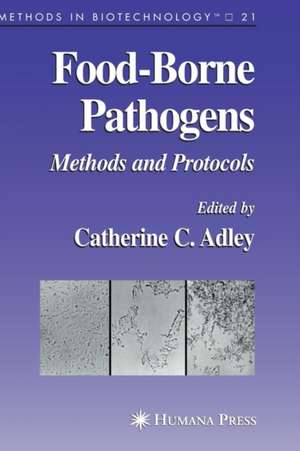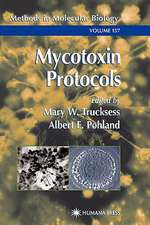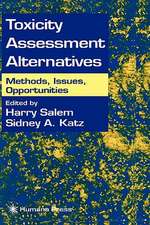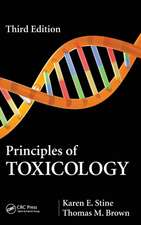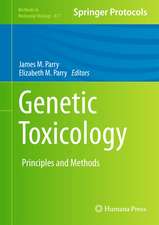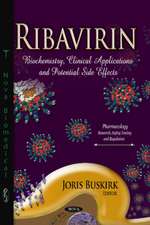Food-Borne Pathogens: Methods and Protocols: Methods in Biotechnology, cartea 21
Editat de Catherine Adleyen Limba Engleză Hardback – 6 oct 2005
| Toate formatele și edițiile | Preț | Express |
|---|---|---|
| Paperback (1) | 640.24 lei 6-8 săpt. | |
| Humana Press Inc. – 19 noi 2010 | 640.24 lei 6-8 săpt. | |
| Hardback (1) | 651.19 lei 6-8 săpt. | |
| Humana Press Inc. – 6 oct 2005 | 651.19 lei 6-8 săpt. |
Din seria Methods in Biotechnology
- 15%
 Preț: 648.74 lei
Preț: 648.74 lei - 15%
 Preț: 656.43 lei
Preț: 656.43 lei - 15%
 Preț: 650.69 lei
Preț: 650.69 lei - 15%
 Preț: 639.90 lei
Preț: 639.90 lei - 18%
 Preț: 953.52 lei
Preț: 953.52 lei - 18%
 Preț: 969.93 lei
Preț: 969.93 lei - 18%
 Preț: 954.14 lei
Preț: 954.14 lei - 18%
 Preț: 952.57 lei
Preț: 952.57 lei - 18%
 Preț: 963.15 lei
Preț: 963.15 lei - 18%
 Preț: 961.23 lei
Preț: 961.23 lei - 15%
 Preț: 652.31 lei
Preț: 652.31 lei - 18%
 Preț: 953.52 lei
Preț: 953.52 lei - 18%
 Preț: 962.35 lei
Preț: 962.35 lei - 18%
 Preț: 955.56 lei
Preț: 955.56 lei - 15%
 Preț: 649.87 lei
Preț: 649.87 lei - 18%
 Preț: 964.71 lei
Preț: 964.71 lei - 15%
 Preț: 648.05 lei
Preț: 648.05 lei - 15%
 Preț: 632.66 lei
Preț: 632.66 lei - 15%
 Preț: 643.99 lei
Preț: 643.99 lei
Preț: 651.19 lei
Preț vechi: 766.10 lei
-15% Nou
Puncte Express: 977
Preț estimativ în valută:
124.62€ • 135.32$ • 104.68£
124.62€ • 135.32$ • 104.68£
Carte tipărită la comandă
Livrare economică 22 aprilie-06 mai
Preluare comenzi: 021 569.72.76
Specificații
ISBN-13: 9781588294654
ISBN-10: 158829465X
Pagini: 268
Ilustrații: XII, 268 p.
Dimensiuni: 155 x 235 x 26 mm
Greutate: 0.72 kg
Ediția:2006
Editura: Humana Press Inc.
Colecția Humana
Seria Methods in Biotechnology
Locul publicării:Totowa, NJ, United States
ISBN-10: 158829465X
Pagini: 268
Ilustrații: XII, 268 p.
Dimensiuni: 155 x 235 x 26 mm
Greutate: 0.72 kg
Ediția:2006
Editura: Humana Press Inc.
Colecția Humana
Seria Methods in Biotechnology
Locul publicării:Totowa, NJ, United States
Public țintă
ResearchCuprins
The Bacteria.- Detection of Hemolysins in Aeromonas spp. Isolates From Food Sources.- Detection and Purification of Bacillus cereus Enterotoxins.- Campylobacter.- Detection of Clostridium botulinum by Multiplex PCR in Foods and Feces.- Multiplex PCR for Specific Identification of Enterohemorrhagic Escherichia coli Strains in the O157:H7 Complex.- PulseNet’s Step-by-Step Laboratory Protocol for Molecular Subtyping of Listeria monocytogenes by Macrorestriction and Pulsed-Field Gel Electrophoresis.- Plesiomonas shigelloides.- Pulsed-Field Gel Electrophoresis As a Molecular Technique in Salmonella Epidemiological Studies.- Kits for Detection of Food Poisoning Toxins Produced by Bacillus cereus and Staphylococcus aureus.- Microbiological and Molecular Methods to Identify and Characterize Toxigenic Vibrio cholerae From Food Samples.- HPLC Measurement of Aflatoxin B1 and Metabolites in Isolated Rat Hepatocytes.- The Viruses.- Detection of Noroviruses of Genogroups I and II in Drinking Water by Real-Time One-Step RT-PCR.- Detection of Enteroviruses.- Detection of Hepatitis A Virus and Rotavirus Using Nucleic Acid Sequence-Based Amplification.- The Parasites.- Isolation and Characterization of Cathepsin-L1 Protease From Fasciola hepatica Excretory-Secretory Products for Serodiagnosis of Human Fasciolosis.- Molecular Biology Methods for Detection and Identification of Cryptosporidium Species in Feces, Water, and Shellfish.- Molecular Identification of Nematode Worms From Seafood (Anisakis spp. and Pseudoterranova spp.) and Meat (Trichinella spp.).- Parallel Studies to the Analysis of Food-Borne Pathogens.- Approaches to Developing Quantitative Risk Assessment Models.- A Review of Surveillance Networks of Food-Borne Diseases.
Textul de pe ultima copertă
The large-scale production and distribution of prepared foods have made rapid and accurate biological testing a daily necessity for the food industry. In Food-Borne Pathogens: Methods and Protocols, expert laboratory scientists describe in a readily reproducible format the classic and emerging molecular methods for the laboratory isolation and identification of the pathogens, viruses, and parasites that cause food-borne disease. Among the pathogens covered are specific bacteria, including Salmonella spp., Campylobacter spp., Listeria spp., and Bacillus spp.; viruses, including noroviruses and enteroviruses, and parasites, including Cryptosporidium and seafood nematode worms. The authors also review toxin detection kits, the use of high performance liquid chromatography, the proper control of bacterial storage conditions, and the importance of surveillance systems and risk assessment. The protocols follow the successful Methods in Biotechnology™ series format, each offering step-by-step laboratory instructions, an introduction outlining the principles behind the technique, lists of the necessary equipment and reagents, and tips on troubleshooting and avoiding known pitfalls.
Cutting-edge and highly practical, Food-Borne Pathogens: Methods and Protocols offers food technologists and research scientists alike an accessible source of molecular techniques currently being used and new methodologies for testing organisms that might not have been attempted previously.
Cutting-edge and highly practical, Food-Borne Pathogens: Methods and Protocols offers food technologists and research scientists alike an accessible source of molecular techniques currently being used and new methodologies for testing organisms that might not have been attempted previously.
Caracteristici
Includes supplementary material: sn.pub/extras
